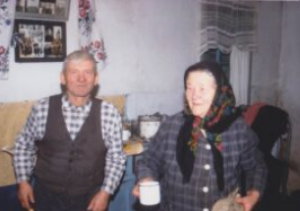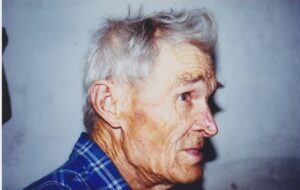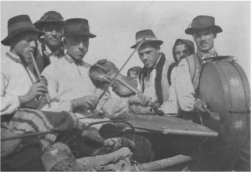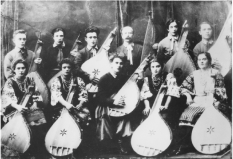—Where did you go to work?
Maria Serhiïvna: I worked for the people here: I grazed the cow and looked after the children. Then I went to another village and served at a rich man’s homestead.
—Were they khaziaii?
Maria Serhiïvna: Yes, they had their farmstead.
—How did they pay you?
Maria Serhiïvna: I had an agreement with them to receive twenty pounds of grain per year. I worked all year long. In the winter, I looked after the horses, cows, sheep, and pigs. In the summer, I worked in the field plowing and sheaving. In the fall, I would stack hay on the steam engine along with the men. I was fifteen. I did this in 1921. Then I went to work in Zolotonosha because by then I needed clothes to wear. I was growing up but had nothing to wear because there were ten of us children in the family. I worked for three years for a good Jewish family. I earned all I needed and even saved money to purchase down to put into pillows. That’s it.
………………………………………………………………………………………..
—When the kolhosp was starting in your village, did your parents join right away?
Maria Serhiivna: My grandfather went first along with his brother. My mother-in-law and I didn’t want to join. They came and said, “We’re in the kolhosp already.” Like that.
—What about your husband?
Maria Serhiivna: Some who didn’t want to join were forced, but my grandfather and his brother volunteered to join.
………………………………………………………………………………………..
—During collectivization, were many people deported from the village?
Maria Serhiivna: Many. Not one from my relatives.
—Did they return later on?
Maria Serhiivna: No one came back, no one.
………………………………………………………………………………………..
—Who was the head of the kolhosp?
Maria Serhiivna: Ivan Svyrydovych, a village man. He was so illiterate and ill-mannered. When the thresher was operating, he would load the stacks.
—Did the newcomers manage the kolhosp?
Maria Serhiivna: They were newcomers, but who they were we still don’t know.
………………………………………………………………………………………
—How much were you paid?
Maria Serhiivna: Paid? We worked for free at the time, for a mark in the records. They [kolhospnyky] used to joke: “There’s a woman sitting on a blanket, counting the workdays; she counted ten days for one workday.” Such were our “earnings.” I’m telling you the truth.
………………………………………………………………………………………
—Where did people get the money or food?
Maria Serhiivna: We ate whatever grew in our vegetable garden—pumpkins, potatoes. The famine was terrible; we suffered so much!
—Where did you get the money to buy clothes?
Maria Serhiïvna: We had nothing, I’m telling you. Only the food we produced by ourselves. Someone would give us sugar, so we’d take it to the market to sell.
………………………………………………………………………………………
—During the time when churches were open, did the priests come to funerals?
Maria Serhiivna: Of course they did. People used to bring them to funerals back in the day just as they do now.
—After the church was closed down, what were the funerals like?
Maria Serhiivna: Without the priests.
—Did someone read the prayers during the funerals in the village?
Maria Serhiivna: Those read who knew how to do it.
—Were the funeral singers paid?
Maria Serhiivna: What would they pay with? Sometimes, they might get a kerchief. People gave what they could.
………………………………………………………………………………………
—Did people sing koliadky and shchedrivky?
Maria Serhiivna: Yes, they sang both. Boys and girls went separately.
—After the kolhospy, did people continue singing shchedrivky?
Maria Serhiivna: Yes, they did.
—Did the schoolteachers scold you for caroling?
Maria Serhiivna: We would gather at home to do it.
………………………………………………………………………………………
—What dances did people dance at weddings?
Maria Serhiivna: People danced whatever they played: polka, krakowiak, and hopak.
—Did people dance barefoot?
Maria Serhiivna: Yes.
—What was the music like at the weddings?
Maria Serhiivna: It was whoever they could hire. The richer people could hire better musicians.
—What instruments?
Maria Serhiivna: Harmonia and bubon.
—What musicians did the poor people hire?
Maria Serhiivna: Perhaps their relatives played for them.
—Were there any weddings without music?
Maria Serhiivna: No, there’d always be some simple music and people would dance.
—Who played?
Maria Serhiivna: The guys did.
—Did the girls play?
Maria Serhiivna: No.
………………………………………………………………………………………
—Did you celebrate Kupala Night?
Maria Serhiivna: Ivana Kupala? Back in the day, people jumped across the fire.
—Did you make wreaths?
Maria Serhiivna: Yes, and we’d float them on the water. We also put them on cabbage heads in the garden, so the cabbage would grow as nice as the wreaths were.
—What songs did you sing for Kupala?
Maria Serhiivna: What songs did we have at the time? Anything people knew. Now they celebrate Kupala Night, too.
—Did you do the goat dance [kozla vodyly]?
Maria Serhiivna: We didn’t have such songs.





